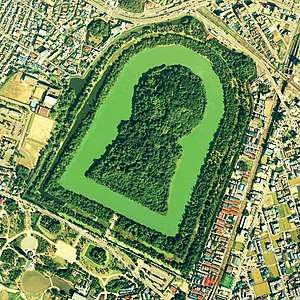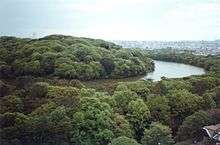Emperor Nintoku
Emperor Nintoku (仁徳天皇, Nintoku-tennō), also known as Ohosazaki no Sumeramikoto (大鷦鷯天皇) was the 16th Emperor of Japan,[2] according to the traditional order of succession.[3]
| Nintoku | |
|---|---|
 | |
| Emperor of Japan | |
| Reign | 313–399 (traditional)[1] |
| Predecessor | Ōjin |
| Successor | Richū |
| Born | 257 (traditional) |
| Died | February 7th, 399 (traditional, aged 142) |
| Burial | Mozu no Mimihara no naka no misasagi (百舌鳥耳原中陵) (Osaka) |
| Spouse | |
| Issue | See below |
| House | Imperial House of Japan |
| Father | Emperor Ōjin |
| Mother | Nakatsu-hime |
| Religion | Shinto |
No firm dates can be assigned to this Emperor's life or reign, but he is conventionally considered to have reigned from 313 to 399.[4]
Legendary narrative
Nintoku is regarded by historians as a "legendary Emperor" of the 5th century.[5] The reign of Emperor Kinmei (A.D. c. 509 – 571), the 29th Emperor,[6] is the first for which contemporary historiography is able to assign verifiable dates;[7] however, the conventionally accepted names and dates of the early Emperors were not to be confirmed as "traditional" until the reign of Emperor Kanmu (737–806), the 50th sovereign of the Yamato dynasty.[8]
According to the Nihon Shoki, he was the fourth son of Emperor Ōjin and his mother was Nakatsuhime no Mikoto, a great-granddaughter of Emperor Keikō. He was also the father of Emperors Richū, Hanzei, and Ingyō. His name was Ohosazaki no Mikoto (大鷦鷯尊).
Nintoku's contemporary title would not have been tennō, as most historians believe this title was not introduced until the reigns of Emperor Tenmu and Empress Jitō. Rather, it was presumably Sumeramikoto or Amenoshita Shiroshimesu Ōkimi (治天下大王), meaning "the great king who rules all under heaven". Alternatively, Nintoku might have been referred to as ヤマト大王/大君 or the "Great King of Yamato".
Events of Nintoku's life
Although the Nihon Shoki states that Nintoku ruled from 313 to 399, modern research suggests those dates are likely inaccurate.[9]
The achievements of Nintoku's reign which are noted in the Nihon Shoki include:
- constructed a thorn field bank called Naniwa no Horie to prevent a flood in Kawachi plains and for development. It is assumed that this was Japan's first large-scale engineering works undertaking
- established a thorn field estate under the direct control of the Imperial Court (mamuta no miyake)
- constructed a Yokono bank (horizontal parcel, Ikuno-ku, Osaka-shi)[10]
Consorts and children
Empress (first): Princess Iwa (磐之媛命), poet and daughter of Katsuragi no Sotsuhiko (葛城襲津彦)
- First Son: Prince Ōenoizahowake (大兄去来穂別尊), later Emperor Richū
- Prince Suminoe no Nakatsu (住吉仲皇子, d.399)
- Third Son: Prince Mizuhawake (瑞歯別尊), later Emperor Hanzei
- Fourth Son: Prince Oasatsuma Wakugo no Sukune (雄朝津間稚子宿禰尊), later Emperor Ingyō
- Prince Sakoudo (酒人王)
Empress (second): Princess Yata (八田皇女), Emperor Ōjin's daughter
Consort: Himuka no Kaminaga-hime (日向髪長媛), Morokata no Kimi Ushimoroi's daughter
- Prince Ookusaka (大草香皇子, d.454)
- Princess Kusaka no hatabi-hime (草香幡梭姫皇女), married to Emperor Yūryaku
Consort: Uji no Wakiiratsume (宇遅之若郎女), daughter of Emperor Ōjin
Consort: Kuro-hime (黒日売), daughter of Kibi no Amabe no Atai (吉備海部直)
Nintoku's tomb


Daisen Kofun (the largest tomb in Japan) in Sakai, Osaka, is considered to be his final resting place. The actual site of Nintoku's grave is not known.[2]
The Nintoku-ryo tumulus is one of almost 50 tumuli collectively known as "Mozu Kofungun" clustered around the city, and covers the largest area of any tomb in the world. Built in the middle of the 5th century by an estimated 2,000 men working daily for almost 16 years, the Nintoku tumulus, at 486 meters long and with a mound 35 meters high, is twice as long as the base of the famous Great Pyramid of Pharaoh Khufu (Cheops) in Giza.[11]
The Imperial tomb of Nintoku's consort, Iwa-no hime no Mikoto, is said to be located in Saki-cho, Nara City.[12] Both kofun-type Imperial tombs are characterized by a keyhole-shaped island located within a wide, water-filled moat. Imperial tombs and mausolea are cultural properties; but they are guarded and administered by the Imperial Household Agency (IHA), which is the government department responsible for all matters relating to the Emperor and his family. According to the IHA, the tombs are more than a mere repository for historical artifacts; they are sacred religious sites. IHA construes each of the Imperial grave sites as sanctuaries for the spirits of the ancestors of the Imperial House.[9]
Nintoku is traditionally venerated at a memorial Shinto shrine (misasagi) at Osaka. The Imperial Household Agency designates this location as his mausoleum. It is formally named Mozu no Mimihara no naka no misasagi.[13]
See also
- Emperor of Japan
- List of Emperors of Japan
- Imperial cult
- Five kings of Wa
- Ujigami Shrine
References
- Aston, William George. (1896). Nihongi: Chronicles of Japan from the Earliest Times to A.D. 697. London: Kegan Paul, Trench, Trubner. OCLC 448337491
- Brown, Delmer M. and Ichirō Ishida. (1979). Gukanshō: The Future and the Past. Berkeley: University of California Press. ISBN 978-0-520-03460-0; OCLC 251325323
- Ponsonby-Fane, Richard Arthur Brabazon. (1959). The Imperial House of Japan. Kyoto: Ponsonby Memorial Society. OCLC 194887
- Titsingh, Isaac. (1834). Nihon Ōdai Ichiran; ou, Annales des empereurs du Japon. Paris: Royal Asiatic Society, Oriental Translation Fund of Great Britain and Ireland. OCLC 5850691
- Varley, H. Paul. (1980). Jinnō Shōtōki: A Chronicle of Gods and Sovereigns. New York: Columbia University Press. ISBN 978-0-231-04940-5; OCLC 59145842
Specific
- "Genealogy of the Emperors of Japan" at Kunaicho.go.jp; retrieved 2013-8-28.
- Imperial Household Agency (Kunaichō): 仁徳天皇 (16); retrieved 2013-8-28.
- Titsingh, Isaac. (1834). Annales des empereurs du japon, pp. 22–24; Brown, Delmer M. (1979). Gukanshō, pp. 256–257; Varley, H. Paul. (1980). Jinnō Shōtōki, pp. 110–111.
- Ponsonby-Fane, Richard. (1959). The Imperial House of Japan, p. 36.
- Kelly, Charles F. "Kofun Culture", Japanese Archaeology. 27 April 2009.
- Titsingh, pp. 34–36; Brown, pp. 261–262; Varley, pp. 123–124.
- Hoye, Timothy. (1999). Japanese Politics: Fixed and Floating Worlds, p. 78; excerpt, "According to legend, the first Japanese Emperor was Jinmu. Along with the next 13 Emperors, Jinmu is not considered an actual, historical figure. Historically verifiable Emperors of Japan date from the early sixth century with Kinmei.
- Aston, William. (1896). Nihongi, pp. 109.
- Parry, Richard Lloyd. "Japan guards the Emperors' secrets; Ban on digs in ancient imperial tombs frustrates archaeologists", The Independent (London). 12 November 1995.
- Aston, William. (1998). Nihongi, Vol. 1, pp. 254–271.
- Merueñas, Mark. "Where Emperors sleep: Japan's keyhole-shaped burial mounds". GMA News Online. Retrieved 2017-09-20.
- Iwa-no hime no Mikoto's misasagi -- map (upper right) Archived 2012-02-07 at the Wayback Machine
- Ponsonby-Fane, p. 419.
External links
| Wikimedia Commons has media related to Emperor Nintoku. |
| Regnal titles | ||
|---|---|---|
| Preceded by Emperor Ōjin |
Emperor of Japan: Nintoku 313–399 (traditional dates) |
Succeeded by Emperor Richū |
